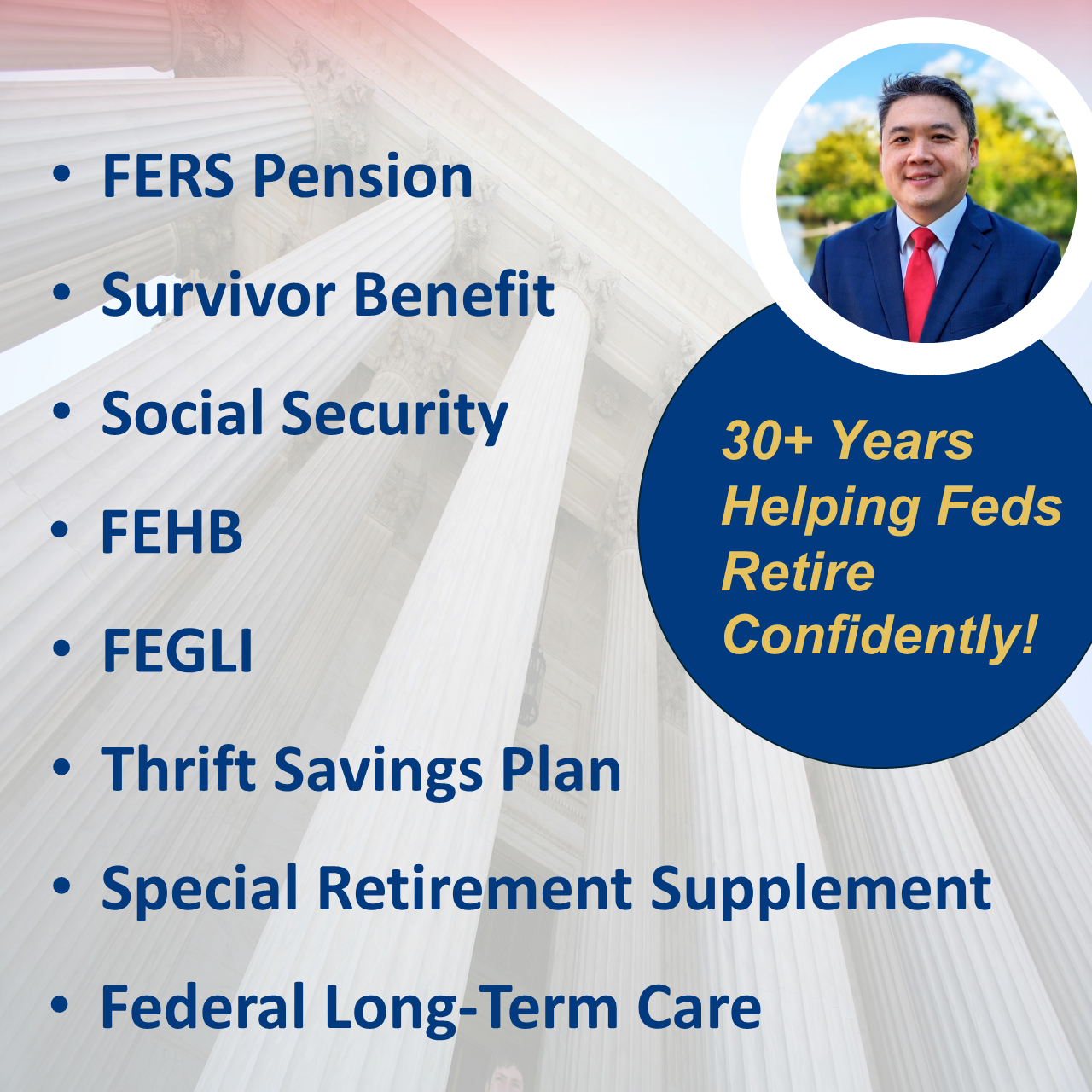Federal Employee Retirement System (FERS): Service Deposits and Timing Your Exit. Is there enough time to retire in 2025 and make a redeposit or military deposit?
Federal Employee Retirement: FERS Redeposit, Military Deposits, and Timing Your Exit from the Government
The deferred resignation program allowed federal employees to leave their agency with pay continuing until either September 30 or December 31, 2025. These dates are also the deadline to apply for retirement, if eligible. There is also a July 15 deadline for OPM accepting paper-based retirement applications. If federal employees are trying to retire before the end of the year, it might be too late for making a FERS redeposit or Military service deposit. In this article, we’ll explore why and provide an overview for timing your federal retirement in 2025.
Estimate your Federal Retirement Benefit with our FERS Calculator.
FERS Redeposit and Military Deposit Processing Times
Both redeposits of retirement deductions for previous federal civilian service and deposits for military service, the average processing time from start to finish takes about two to six months. If not completed before applying for retirement, the opportunity to make either is lost. For FERS coverage, the redeposit can be made after submitting your application to OPM, but not after the pension has been finalized. This provides a very slim window to make a last chance redeposit for prior service in a different position subject to FERS. Military deposits, on the other hand, must be completed before applying for an immediate FERS annuity, a postponed annuity (known as MRA plus 10 retirement), or a deferred pension. For those recently subjected to a RIF or an early retirement because of an involuntary separation from federal employment, the deadlines might be too short to complete the redeposit or deposit for other government service.
Need help with your retirement plan? Meet with a Fed-Expert Financial Planner.
FERS Redeposit of Refunded Contributions
For federal employees who leave federal service, receive refunded retirement contributions under FERS, and later return to federal service, the employee might have the option to redeposit those funds to restore credit for that service in your retirement calculations. Historically, refunded FERS contributions could not be redeposited, meaning that the service period covered by the refund would not count toward your annuity computation. However, a law passed in 2009 (PL 111-84) changed this rule, allowing individuals covered by FERS on or after October 28, 2009, to make a redeposit for refunded FERS service.
Key Points About FERS Redeposits:
- Impact on Retirement Benefits: If you do not repay the refunded contributions, the service period will still count toward retirement eligibility and the high-3 average salary computation, but it will not be included in the annuity calculation.
- Interest on Redeposits: Redeposits must include interest, which accrues over time.
Understanding Service Deposits for Military Service
Military deposits allows employees to include their military service as creditable service under FERS, potentially increasing their retirement income. The deposit amount is based on a percentage of the military base pay, and paying it can significantly enhance retirement benefits. Understanding the process and benefits of making a service deposit is crucial for employees with military service who are planning their retirement. Read this article to learn how making military deposits early can be save a significant amount of money.
Calculating the Cost and Benefits of Making Deposits
Calculating the cost and benefits of making service deposits and redeposits involves evaluating the potential increase in retirement benefits against the financial outlay required. Employees should consider factors such as the length of military service, the amount of withdrawn contributions, and the interest accrued on redeposits. Using OPM tools and consulting with retirement specialists can help employees make informed decisions about whether to pursue these options. Ultimately, making deposits can be a strategic move to enhance retirement security.
CSRS Redeposit Information
For CSRS (Civilian Service Retirement System), prior service counts automatically when they separate for retirement, up to service before March 1, 1991. They can make a redeposit for service to increase the amount of their retirement, or accept a reduction. The years of civilian service after that are similar to FERS with a CSRS retirement. It counts toward eligibility but not the pension calculation unless a redeposit is made with interest.
How to Calculate Your FERS Retirement Annuity
For an in-depth overview of how to calculate FERS retirement benefits, read this article about how to calculate your federal pension.
Coverage into Retirement: Factors Affecting Your Retirement Annuity
Several factors can influence the amount of the FERS retirement annuity. These include the employee’s age, total years of creditable service at retirement, and whether they meet age and service requirements for an immediate, postponed, or deferred pension. Additionally, any service under FERS may include military service or periods of leave without pay that can impact the annuity calculation.
Age and Service Requirements for FERS Retirement
Minimum Retirement Age (MRA) Explained
The Minimum Retirement Age (MRA) is a critical concept in FERS, determining when federal employees are eligible to retire with immediate benefits. The MRA varies based on the employee’s year of birth, ranging from 55 to 57 years. Meeting the MRA is essential for accessing certain retirement options, such as the MRA+10 retirement, which allows employees to retire with reduced benefits if they have 10 or more years of service. Understanding the MRA is crucial for planning the timing of retirement and ensuring eligibility for desired benefits.
Minimum Age and Service Requirements for Immediate Retirement
To qualify for immediate retirement under FERS, federal employees must meet specific age and service requirements. Generally, employees can retire at age 62 with at least five years of service, at age 60 with 20 years of service, or at the MRA with 30 years of service. These requirements ensure that employees have accumulated sufficient years of service to qualify for full retirement benefits. Immediate retirement must provide a stable income stream through the FERS annuity, supplemented by Social Security and TSP withdrawals. To retire at an earlier age or with less service time, deferred and postponed retirement options are available.
Deferred and Early Retirement Options
FERS offers deferred and early retirement options for employees who do not meet the immediate retirement criteria. Deferred retirement allows employees who separate from federal service before meeting the age and service requirements to receive a deferred annuity at age 62. Early retirement options, such as through Voluntary Early Retirement Authority (VERA) or a Discontinued Service Retirement (DSR), provide opportunities for employees to retire before reaching the MRA or age 62, often in response to workforce restructuring or downsizing, like in 2025. Both have the following age and service requirements: 25 years of service at any age or 20 years at age 50 or older.
When is the Best Time for a Federal Employee to Retire?
Meeting certain age and service requirements to be eligible for an immediate FERS pension doesn’t necessarily mean you will have sufficient income to last throughout retirement. Whether at age 62 with five years of creditable civilian, or at the MRA with 30 years, there are multiple facets that need to be considered when determining an individual’s retirement readiness. Special provisions employees are subject to mandatory retirement at age 56 or 57 with 20 years of creditable service, must especially ensure they are financially prepared.
Subscribe to Our Newsletter and Receive a Free FERS Handbook
Factors to Consider When Timing Your Retirement
A lot of federal retirees find they were financially underprepared for retirement, mostly due to underestimating taxes and healthcare costs, and mismanaging their TSP investments. Timing is a critical factor in maximizing retirement benefits under FERS. Employees should consider various factors, including their age, years of service, financial readiness, and personal goals. The decision to retire should align with the employee’s overall retirement strategy, taking into account the impact of Social Security benefits, TSP withdrawals, and potential health care costs. Additionally, employees should consider the implications of retiring at different ages, such as age 62, when Social Security benefits become available. Now read this article to learn the optimal retirement age for federal workers.
Reach Out to Us!
If you have additional federal benefit questions, contact our team of CERTIFIED FINANCIAL PLANNER™ (CFP®), Chartered Federal Employee Benefits Consultants (ChFEBC℠), and Accredited Investment Fiduciaries (AIF®). At PlanWell, we are federal employee financial advisors with a focus on retirement planning. Learn more about our process designed for the career fed.
Preparing for federal retirement? Check out our scheduled federal retirement workshops. Sign up for our no-cost federal retirement webinars in our workshop calendar. Make sure to plan ahead and reserve your seat for our FERS webinar, held every three weeks. Want to have PlanWell host a federal retirement seminar for your agency? Reach out, and we’ll collaborate with HR to arrange an on-site FERS seminar.
Want to fast-track your federal retirement plan? Skip the FERS webinar and start a one-on-one conversation with a ChFEBC today. You can schedule a one-on-one meeting through our Contact page.










